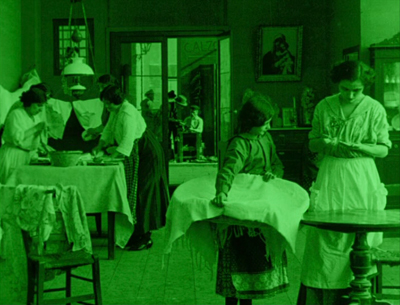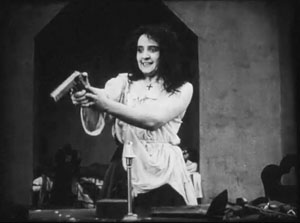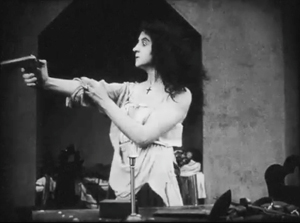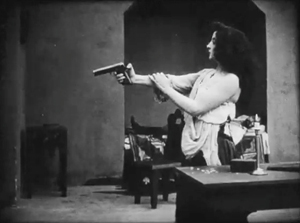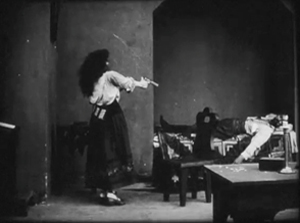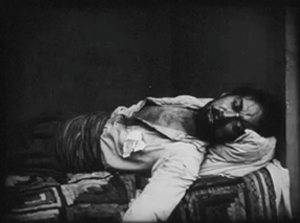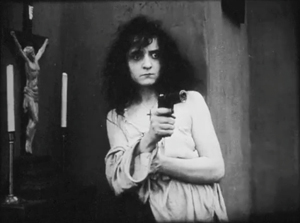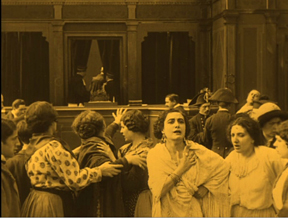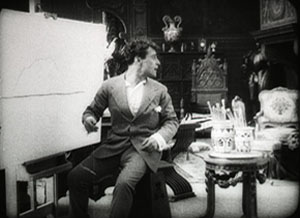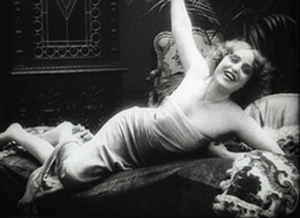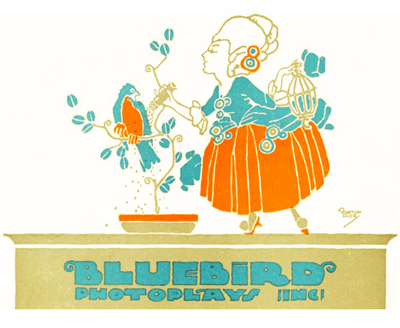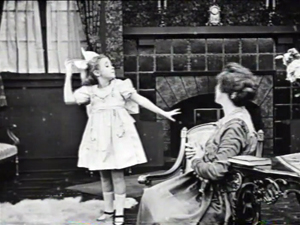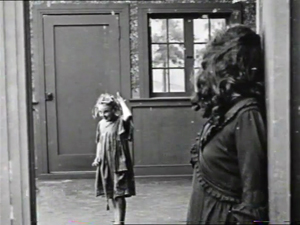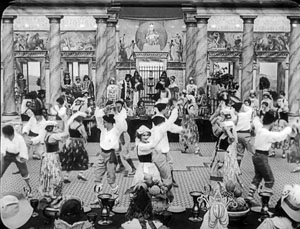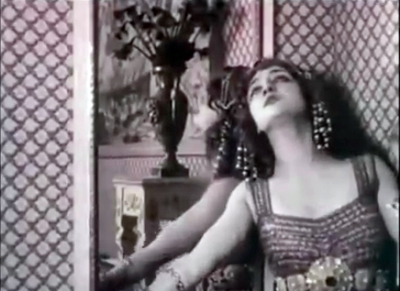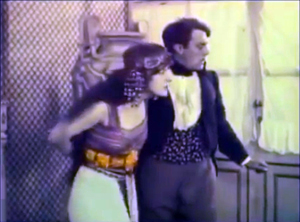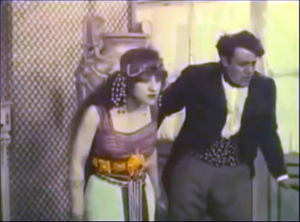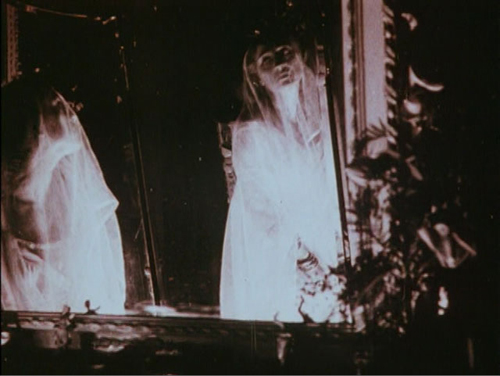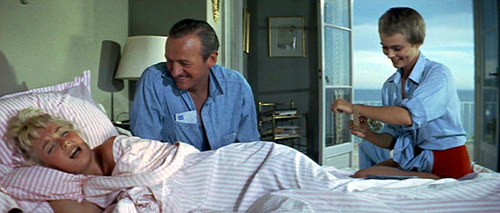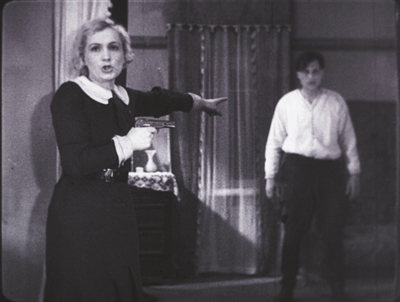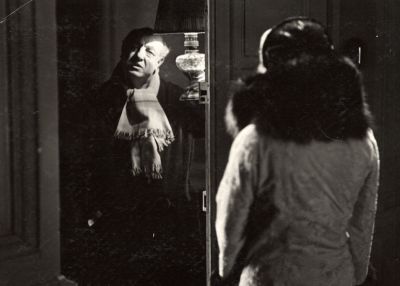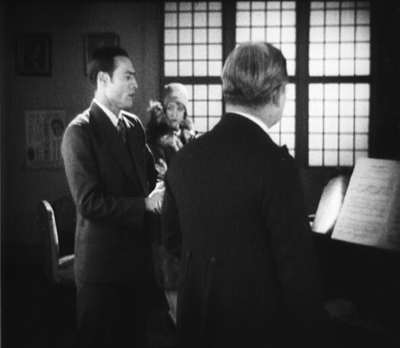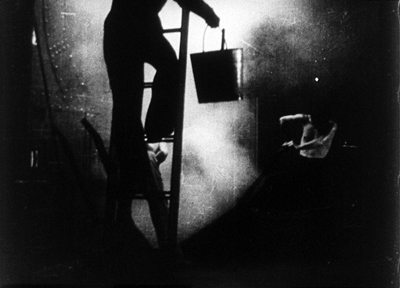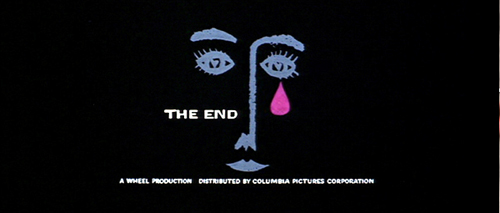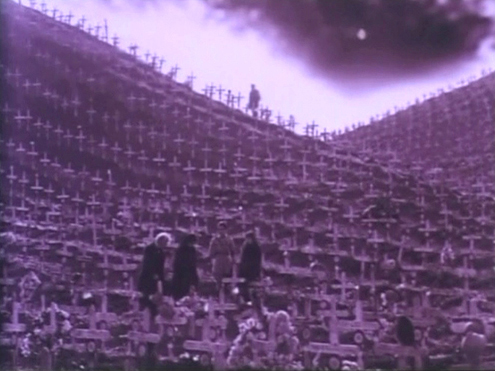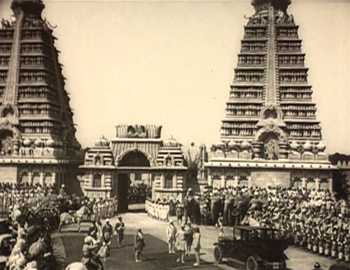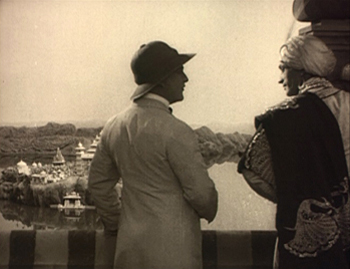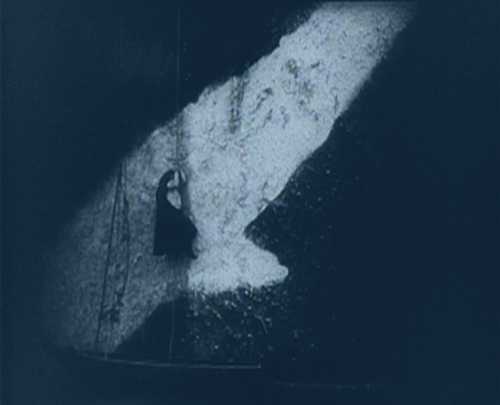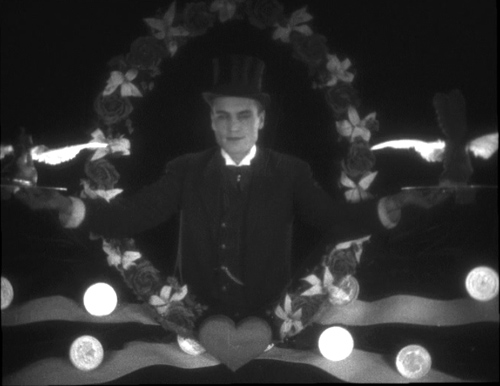Archive for the 'Directors: Weber' Category
Il Cinema Ritrovato: Back to the future (of movies)
DB here:
The Teatro Comunale of Bologna is an eighteenth-century opera house that was launched by a premier of a work by Glück. It has hosted massive productions of Wagner, Rossini, and Verdi, and was a favorite venue of Toscanini’s. Elegant and imposing, with box seats and an orchestra pit, it makes you feel like you’re in Senso or Liebelei.
In some years Cinema Ritrovato has secured the Teatro for gala screenings of silent films, complete with orchestral accompaniment. One show of Lady Windermere’s Fan was a delight. In another year, the hammering Meisel score for The Battleship Potemkin nearly blasted me out of my seat. I was sitting up front.
This year it was Rapsodia Satanica (1917) that got the Comunale treatment. This apparition has lost none of its exuberant morbidity, and we got to watch it with the original Pietro Mascagni score. Timothy Brock found that the original orchestra parts were lacking hundreds of tempo changes, because Mascagni himself conducted during screenings and never inserted them. Through careful testing against the film, Brock managed to create a score that brought a packed Communale audience to its feet cheering. One more testament to the power of 1910s cinema.
1915 and all that
Assunta Spina (1915).
I tried, really tried, to see other wonders from all the places and periods on display at this year’s overstuffed Ritrovato. But because of my love of ‘teens films, both American and not, I kept coming back to as many items from that era as I could squeeze in.
There was, centrally, the series Cento Anni Fa (A Hundred Years Ago), curated by Marianne Lewinsky and Giovanni Lasi. 1915 was, of course, a decisive year in American cinema, to be forever identified with Griffith’s monumental The Birth of a Nation. Standard histories would have it that this was the stroke that revealed the artistic power of cinematic storytelling. Griffith’s colossus was naturally very influential, but it wasn’t an isolated accomplishment. Earlier films, such as Weber/Smalley’s Suspense (1913), and other 1915 films–De Mille’s The Cheat and Walsh’s Regeneration in particular–are more typical stylistically of what Hollywood silent cinema would turn out to be.
Add to this list another 1915 item. If film history were an exercise in fairness, Reginald Barker would be recognized as one of the directors who set American filmmaking on its “classical” road. Working under Thomas Ince’s supervision, Barker showed a flair for economical framing, frequent changes of setup, and bold cutting within scenes. His Typhoon (1914) is at many moments more nuanced in its analytical editing than Birth.
1915 was a fine year for Barker. He turned out the long-praised The Italian (shown in the series), as well as the dynamic Civil War drama The Coward, along with superb William S. Hart westerns like On the Night Stage.
So The Despoiler, another Barker from 1915, did not disappoint. It survives only in a cut-down French print, but it still packs a sensational punch.
The original, according to a contemporary review, involves a border war in which troops invade a small town. The leader of the dark-skinned horde fastens on one beautiful woman, who has taken refuge in a nunnery. She is about to sacrifice herself to save the others, when the colonel learns that she is his own daughter. She is saved, and at the very end the whole thing is shown to have been a dream. The French version Châtiment (“Punishment”), painstakingly restored by the Cinémathèque Française in 2010, was modified to fit propaganda demands of the war period. Here the daughter really gets raped, and she shoots her attacker. The colonel turns his troops loose on the nunnery, but halts them in time when he realizes who the victim is. No dream stuff here.
Barker’s style is fluid, and he builds great suspense when the daughter, barely recovered, prepares to shoot her ravisher with his own pistol. The scene has judicious depth staging, as when the soldier lies drunkenly on the cot but he’s blocked by the woman’s gradual decision to use the weapon. At the proper moment she swivels aside to reveal his head lolling in the background.
The match-on-action when the woman turns and pulls up her sleeve is more perfect than many such cuts in Griffith’s films. She then strides to the background to give us a full view of her target.
A brief shot of the daughter’s attacker is replaced by a 3/4 view of her drawing a bead on him, with Jesus taking her side.
Other countries’ 1915 output wasn’t ignored. We got Denmark’s Revolutionary Wedding, proof that August Blom had not given up the somewhat rigid version of the tableau style he had used in Atlantis (1913). More florid were the Italian offerings. Assunta Spina (lovingly restored by Bologna’s own Cineteca and now available in a DVD), is a classic of the nation’s silent cinema. It was treated to a carbon-arc projection one evening in the courtyard. The less-known but no less flamboyant Il Fuoco (“The Fire”) is a melodrama about a rich woman who destroys a naive, passionate painter.
The two films are famous for showcasing the divas Francesa Bertini and Pina Menicelli respectively. But they’re just as important as powerful illustrations of the variety of 1915 pictorial styles. Assunta Spina is a triumph of tableau staging. By contrast, the opening of Il Fuoco, detailing the first encounter of the owl-woman and the burly artist, is as rigorous a piece of editing that I’ve seen anywhere at the period. Assunta Spina fills the frame with layers of depth (above and first still below). Il Fuoco makes play with bold optical POV, especially when the painter is transfixed by his languid model.
To which one can only say: Zowie.
Bluebirds of happiness
Back in the 1980s I wanted to see some films from Universal’s Bluebird Photoplay series. It had been accepted wisdom that the Bluebirds were among the first American films seen in Japan, and accordingly they had influenced Japanese filmmakers. My searchings led me merely to fragments at the Library of Congress. But today, according the Ritrovato’s indispensable catalog, about thirty complete titles have been found in archives. The most famous, Lois Weber’s Shoes (1916), screened at Bologna in 2011.
The Bluebird franchise was identified with feel-good stories, often rom-coms centered on women and derived from fiction by women. Mariann Lewinsky points out that the unit was a training ground for Rudolph Valentino, Mae Murray, Tod Browning, Rex Ingram, and several other notables. A striking number of Bluebirds were directed by women, in particular Elsie Jane Wilson. About 170 films were produced under the logo, and Hiroshi Komatsu’s catalogue entries confirm that they had a powerful impact on Japanese fans and filmmakers.
Four Bluebird titles, all discovered at the French CNC archive, confirmed the ingratiating charm attributed to the brand. Little Eve Edgarton (1916) centers on a botanist daughter who’s whip-smart in science. Her father tries to marry her off to an older colleague, but she resists. The Love Swindle (1918) is more elaborately plotted. The main couple meet cute during a comic home invasion, in which Diana Rosson proves better at defeating hungry tramps than Dick Webster, who gets conked out trying to protect her. After a date, Dick decides Diana’s too modern and highbrow for him. Diana, undaunted, takes a room in a pension and masquerades as her own impoverished sister, Miranda. Dick naturally falls for Miranda.
Here again, the polish and inventiveness of ‘teens Hollywood comes through. Stylistically, we find nearly everything characteristic of classical presentation: scene analysis, angled shot/reverse shot (though no over-the-shoulders), surprising camera movements, expressive low and high framings. In narrative terms, our heroines conceive goals and pursue them tenaciously. Rosamond in The Dream Lady (1918) even makes a list of her four aims in life. Getting a house is surprisingly easy; marrying a real gentleman takes a little longer.
There are as well ambitious storytelling gambits. At one point in The Dream Lady, an orphan girl imagines that she has a mother and lives in nice surroundings. Director Elsie Jane Wilson cuts freely between the girl’s fantasy and Rosamond looking in on her. One startling cut matches on the girl’s gesture of flouncing her ribbon, taking us between dream and reality. (It’s actually a cheat–wrong arm–but perhaps the change of angle covers the disparity. Sort of like here.)
Then there’s the plot of The Little White Savage (1919). It starts with a circus boss and his sidekick telling customers how they acquired a star attraction, a wild girl purportedly from an island on no maps. The flashback yarn is absurd from the get-go, and it gets wilder as it proceeds, as the heroic sidekick somehow goes from he-man adventurer to pious parson. In a surprisingly salacious passage, Minnie, escaped from the sideshow, hops into the clergyman’s bed. They squeeze and nuzzle unashamedly as nosy townsfolks watch in horror.
It’s all a tall tale, of course, confirmed when the frame story reveals Minnie as simply a cute modern girl. The Confession (Fox, 1918), hinged on a more serious lying flashback and may have supplied the premise for The Little White Savage. Again we find the 1910s as an era of fertile innovation. “Its breezy bold difference makes it worthwhile,” wrote a critic of this Bluebird release. “What Paul Powell and scenarist Waldemar Young have done here is the sort of adventure that makes screen progress.”
A bigger-budget Universal release served as pendant to the Bluebirds. Lois Weber’s Dumb Girl of Portici (1916) was a collaboration with dancer Anna Pavlova. A truncated version had long lain at the British Film Institute, but Geo Willeman and Valerie Cervantes found a 16mm print at the New York Public Library. That enabled them to create a very pretty, nearly-complete version, which now concludes with a lengthy Pavlova dance. The super-production, now running nearly two hours, was based on Daniel Aubert’s 1828 opera and offers some ambitious spectacle.
As a prestige entry with crowd scenes, lavish sets, and one of the stage’s top stars, it’s about as far from the humble Bluebirds as you can get. It’s notably stiffer and less dynamic too; what is it about costume pictures that makes for an academic approach? Still, The Dumb Girl of Portici and the Bluebirds exemplify the ways in which filmmakers of the period laid down many paths of exploration for the future.
The devil you know
I first saw Rapsodia Satanica some years back during a Brussels visit. I liked it fine, but seeing it with tinting and hand-coloring, on the big Comunale screen, with a live orchestra convinced me that it really needs its score. The plot is thin, but with the music throbbing along with its heroine’s seductive pirouettes and mournful drifting, the whole thing makes powerful cinema. It was in fact billed as a “Cinematic-Musical Poem,” suggesting that here lyricism will dominate.
With the score tightly matching fluent acting, I’m reminded of a point Kristin made some years ago. She wrote about the ‘teens as an era in which many directors opened up new domains of cinematic expressivity. Having developed effective methods of storytelling, they began looking for techniques that would deepen the emotional impact of the action. Rapsodia satanica is practically a case study for this tendency.
Countess Alba sells her soul to regain youth. One of her suitors kills himself, the other flees. She winds up alone on her estate. This simple story is elaborated through many techniques of mise-en-scène. There are the dancelike performances; Satan practically coils himself around his victim’s calf. There are the costume changes, as Alba moves from her heavy dowager dress to diaphanous veils in her voluptuous phase, and then, in her solitude, a simple shift. When she thinks the surviving lover is about to return, she wraps herself in the veils she wore before. Even the hand-coloring adds impact; as in the pair of stills below, often Alba’s dress is the only colored mass in the shot.
The hallucinatory images gain both precision and passion from the soaring score. Our heroine sells her soul to Satan in exchange for a return to youth. The moment when she sheds her elderly skin and emerges, like the butterfly we’ll see later, as a ravishing beauty is accompanied by a motif that exfoliates just as lushly. An offscreen pistol shot is prepared by a driving crescendo, but the orchestral outburst is still startling. The countess registers the realization that one lover has killed himself, and diva Lyda Borelli synchronizes her attitudes with that climax: body clenched at first, then sliding toward a more doleful pose.
At forty-two minutes, Rapsodia Satanica is practically, as Gian Luca Farinelli remarked in his introduction, an experimental film. Its unsettling use of multiple mirrors, trapping the heroine in fractured reflections, sets up Charles Foster Kane’s zombie-like passage through his palace. The film’s second part, in which the heroine drifts through landscapes and enormous rooms, looks forward to the American “trance films” of the 1940s and the Cinema of Walkies, from Neorealism and Antonioni to Tarkovsky. In all, the film lets us recognize the persistence of some trends across film history, and appreciate that the 1910s are not as far away as they might seem.
Thanks to Guy Borlée and Cecilia Cenciarelli for help with this entry.
The immense catalogue of this year’s Cinema Ritrovato, essential for background to the screenings, can be purchased here. There’s a pdf for reading or downloading here. These folks think of everything.
For contemporary accounts of The Despoiler, see the Lantern pages here and here. The Cinémathèque Française webpage provides a detailed explanation of the restoration. The Photoplay review of The Little White Savage is here.
You can read more about Bluebirds at Adrian Curry’s “Poster of the Week” site on mubi, from which I took the Bluebird logo above. Be sure to scroll down to enjoy the gorgeous designs on display.
For more on why the ‘teens are crucial, see the Vimeo talk, “How Motion Pictures Became the Movies.” On continuity editing, you might start here; on tableau staging, here. Kristin’s article is “The International Exploration of Cinematic Expressivity,” in Karel Dibbets and Bert Hogenkamp, eds., Film and the First World War (1995).
Rapsodia Satanica.
Solo in Bologna
Kristin here:
Two days before David and I were to set out for Bologna and its annual Il Cinema Ritrovato festival, back pain struck him. He decided not to go, and so our coverage this year will be briefer. I struggled to see as much as possible, but if anything, the program was even more packed than last year.
The auteurs
The main threads included four directors who are of historical interest. Raoul Walsh was the main attraction, with emphasis less on familiar classics like Roaring Twenties and White Heat and more on hard-to-see items like Me and My Gal and other early 1930s films. Lois Weber, the first important female director in American cinema, was represented with as complete a retrospective as possible, including fragments from features not otherwise extant. Jean Grémillon, one of the less famous French prestige directors during the 1930s and 1940s, was extensively represented. And there was Ivan Pyriev (or Pyr’ev, going by the program notes’ spelling), most famous as one of the main proponents of the “kholkoz [collective farm] musicals” of the last 1930s and 1940s.
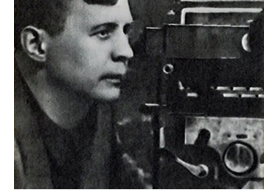 I had seen a couple of Pyriev’s films and decided to see as many as possible of the series on offer, programmed by our long-time front-row neighbor in the Cineteca venues, Olaf Möller. Pyriev is an interesting case historically. He came to filmmaking just as the Soviet Montage movement of the 1920s was coming under official pressure for its formal complexity.
I had seen a couple of Pyriev’s films and decided to see as many as possible of the series on offer, programmed by our long-time front-row neighbor in the Cineteca venues, Olaf Möller. Pyriev is an interesting case historically. He came to filmmaking just as the Soviet Montage movement of the 1920s was coming under official pressure for its formal complexity.
The Civil Servant (or The State Functionary, 1931) was a full-blown, skillful leap into Montage, with an prologue of trains coming into Moscow, shot with canted framings, low angles, and quick cuts with trains moving left, then right. The rest is a satire on bureaucracy within the national railroad system—ostensibly set during the Civil War but clearly a contemporary story. It’s broad in its humor, and it has the obvious typage in the choice of actors, the wide-angle lenses that the Montage filmmakers explored in the late 1920s, and other scenes of quick cutting with jarring reversals of directions.
Official dislike of The Civil Servant kept Pyriev from directing again for three years. Turning his back on Montage, he went to the other extreme, helping to develop the kholkoz (collective-farm) musical and making some of its liveliest, most entertaining, and most enthusiastic examples of that genre. His Traktoristi of 1939 was not shown during the festival, but one that I hadn’t seen, Swineherd and Shepherd (1941), is fully its equal. From the moment the film begins, with the camera madly tracking backward through a birch forest as the heroine runs full tilt after it, singing joyously to the masses of pigs that emerge from corrals and gallop along with her, the spectator realizes that this film will be exactly what one wants and expects from Pyriev.
A later entry in the genre, The Cossacks of the Kuban (1950), was even better, and I can see why it is Olaf’s favorite. The opening vistas of immense wheat fields, gradually moving to scenes with tiny figures and finally to ranks of harvesting machines and trucks achieves a genuine grandeur, aided considerably by the fact that by this point Pyriev is working in color. The story goes beyond the simple stock figures of some of the earlier musicals, with a stubborn Cossack who heads one collective farm nearly missing his chance at romance with a widow who heads a rival farm.
Overall, I like these films a little better than those of his more famous colleague in the creation of buoyant musicals, Grigori Alexandrov. Yet it has to be mentioned that there is a certain underlying unease in being entertained by films that created hugely idealized images of life on collective farms. In reality many peasants were starving, and few were working with such cheerful enthusiasm to increase production for the sake of the great Soviet state. One might rationalize this dissonance by thinking that Pyriev was perhaps making fun of his subject with over-the-top dialogue and musical numbers. Yet surely to many audiences at the time, this was escapist entertainment, and urban audiences may have had little sense of the blatant inaccuracy of the portrayals of the countryside.
Two more straightforward dramas, The Party Card (1936, below) and The District Secretary (1942), a war story, were more conventional Socialist Realist works, skillfully done but lacking the appeal of Pyriev’s lighter films.
It was sad to see the one post-Stalinist film from Pyriev’s late career, his adaptation of The Idiot (1958). A sumptuous production, again in color, it consisted almost entirely of overblown confrontations among characters. The actors shout all their lines at each other with almost no variation in the dramatic tone, with everything underlined by an amazingly intrusive musical score.
I saw only a few of the Walsh films, since they frequently conflicted with the Pyrievs and Grémillons and just about everything else on offer. To me, the director was a bit oversold. Peter von Bagh’s introduction to the catalog says, “Unjustly, Raoul Walsh, although blessed with so much cinephilic worship, is usually placed a few notches below his more revered colleagues Ford and Hawks. Now he will have a chance to be upgraded, in our continuing series featuring extensive screenings from Walsh’s silent period through his very rare early sound films.” Perhaps Walsh will go up a notch in people’s estimations—the screenings of his films were certainly very popular—but not, I think, the few notches it would take to place him alongside these two other masters. I enjoyed Me and My Gal, a rare 1932 comedy in which Spencer Tracy and a very young Joan Bennett adeptly exchange snappy patter, yet it occurred to me more than once during the screening that Twentieth Century (1934) is a much funnier film.
The Big Trail, shone in its original wide-screen Grandeur format on the giant Arlecchino screen, was better than I expected. Walsh was given enormous resources to tell the story of a large wagon train making its way to Oregon from the Mississippi. He showed off the crowds of wagons, cattle, and people by the simple expedient of raising the camera height so that most of the screen’s height became a tapestry of people stretching into the distance, all going about their business while the main dramatic action in the foreground occurred. This often involved a very young John Wayne, whose occasional awkward delivery of lines managed somehow to fit with his character.
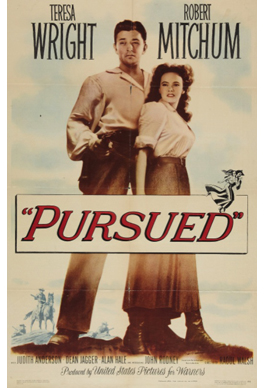 Pursued (1947), shown in an excellent 35mm print, was one of the few certified Walsh masterpieces in the series. Of course I enjoyed it. It struck me how crucial the casting of Teresa Wright as heroine Thor Callum was. So often Westerns have minor actresses as the love interest, women that one can seldom recall seeing in any other film—starlets rather than stars. Thor’s dramatic arc is pretty extreme and somewhat implausible, but Wright manages to make the character convincing and sympathetic, as well as an effective counterpoint to Robert Mitchum’s stolid Jeb Rand. James Wong Howe’s cinematography was also a big plus.
Pursued (1947), shown in an excellent 35mm print, was one of the few certified Walsh masterpieces in the series. Of course I enjoyed it. It struck me how crucial the casting of Teresa Wright as heroine Thor Callum was. So often Westerns have minor actresses as the love interest, women that one can seldom recall seeing in any other film—starlets rather than stars. Thor’s dramatic arc is pretty extreme and somewhat implausible, but Wright manages to make the character convincing and sympathetic, as well as an effective counterpoint to Robert Mitchum’s stolid Jeb Rand. James Wong Howe’s cinematography was also a big plus.
Few of Walsh’s pre-1920s films survive, but those few were shown. I skipped the wonderful Regeneration, having seen it multiple times, but I caught The Mystery of the Hindu Image, notable mainly for Walsh’s own performance as the detective, and Pillars of Society, a somewhat stodgy adaptation of the Ibsen play.
I can’t say much about the Weber films, since they were consistently in conflict with screenings of films by the other main auteurs. I regret having skipped one Pyriev film, Six O’clock in the Evening after the War (1944) to see Shoes (1916), which had been touted as one of the director’s best. It proved a considerable disappointment, stuffed with expository intertitles that often simply described what we could already see from the action in the images. This may have been because Weber’s “discovery,” Mary McLaren, was so inexpressive. She almost constantly wore the same expression of resigned sadness at her family’s grinding poverty, varying it occasionally with a look of annoyance at her father’s shiftless behavior. I tried to steer people to The Blot, which is probably Weber’s masterpiece among the surviving films.
It was fairly easy to see most of the Grémillon titles, because a number of them were repeated in the course of the week. I enjoyed Maldone, which I had seen once long ago. Its story involves a runaway heir to a large estate who has run away as a young man and now, in late middle age, works on a canal barge. Infatuated with a beautiful gypsy and spurned by her, he returns to claim his inheritance, only to be disgusted by gentrified life. Like Pyriev, Grémillon came late to one of the commercial avant-garde movements of the 1920s, French Impressionism. He uses the subjective camera effects and the rhythmic editing in a straightforward way, with little of the flashiness of a L’Herbier or a Gance. Maldone and his subsequent film, Gardiens des phare (1929), shown at the festival in a tinted Japanese print, remind me of perhaps the best filmmaker of the Impressionist movement, Jean Epstein.
This legacy might logically have led Grémillon into the Poetic Realism of France in the 1930s. Unfortunately his first sound film, La petite Lise (1930), which might be said to fit into that tradition, was not shown. After seeing several of the films on offer this year, I still think it may be his masterpiece. (We talk about it briefly in the section on early sound cinema in Film History: An Introduction.) Though some might argue that he has at least one foot in that tradition, his work is perhaps closer to what the Cahiers du cinéma critics later dubbed the Cinema of Quality.
As for the others I caught: L’étrange Monsieur Victor (1938, dominated by Raimu as a successful merchant who is not all he seems), Remorques(1939-41, perhaps Grémillon’s best-known film, re-teaming the favorite French couple of the 1930s, Jean Gabin and Michele Morgan), and Pattes blanches (literally, “White putties,” 1948). I enjoyed them all, and yet there was no sense of discovering an overlooked genius. Best of the sound features for me was Pattes blanches, which tempered Grémillon’s taste for melodrama with a hint of surrealism. The obsessive young wastrel Maurice (played by a very young Michel Bouquet), the gamine hunchback maid who falls in love with the reclusive and menacing local nobleman, and the nobleman himself, invariably bizarrely clad in his white puttees, help give the film a fascination that the others, for me at least, lack.
The themes
There were other threads oriented by genre or topic or period. These I sampled when it was possible to insert them into my schedule. One of these was “After the Crash: Cinema and the 1929 Crisis,” which included an intriguing potpourri of documentaries and fiction films from several countries and political stances, from Borzage’s A Man’s Castle to two short films by Communist-leaning Slatan Dudow, director of Kuhle Wampe. Because of my interest in international cinema styles of the late 1920s and early 1930s, I went to Pál Fejös’s Sonnenstrahl (“Sun Rays,” 1933) was shown in the festival’s first time slot, 2:30 on Saturday afternoon. It thus competed with the first showing of the Grandeur version of The Big Trail and the first program of the “Cento anni fa” set of 96 films from 1912, but such is Bologna’s lavish scheduling.
Fejös, a Hungarian, made films in Hollywood, France, Denmark, Sweden, and a number of other countries. Sonnenstrahl, with its romance between German actor Gustav Fröhlich and French leading lady Annabella, is basically a reworking of the director’s best-known film, Lonesome (1928), with touches of 7th Heaven (Borzage, 1927), redone for the Depression era. It’s a pleasant enough piece, though not up to Fejös’s best work of the 1920s. Again, the program claims to too much for the filmmaker by saying that some historians consider him “as one of the cinema’s great poets, along with Murnau and Borzage.”
The Depression program also included a surprisingly good early sound film by Julien Duvivier, David Golder (1931, above). It’s the story of a wealthy businessman, played by Harry Baur, who discovers that his wife and daughter love him only for his money. How he could have lived this long with them without realizing this is perhaps a weakness in the plot, but from the start Duvivier showed a remarkable assurance in framing, cutting, and camera movement that was continually in evidence. Sets by the great Lazare Meerson also enhanced the style.
Baur also starred as Jean Valjean in Raymond Bernard’s 1934 three-part Les Misérables. I skipped the screenings, since the film is available in a Criterion boxed set (along with Bernard’s remarkable 1932 anti-war film Wooden Crosses). The Bernard film was part of the “Ritrovati and Restaurati” thread. The presence of Baur in both David Golder and Les Misérables led to the Depression and Ritorvati threads to weave together to produce a third: “Homage to Harry Baur.”
The only other entry in this brief thematic collection was Duvivier’s La tête d’un homme (1933), the third film based on a novel by Georges Simenon. Baur stars as Commissioner Maigret, and Valery Inkijinoff (known largely as the hero of Pudovkin’s Storm over Asia/The Heir of Ghengis Khan, though he acted in numerous other films as well) plays the doomed, obsessive villain, Radek. The film is not as accomplished as David Golder, but it’s an entertaining little thriller with some novel twists. Early in the film the murder is revealed, and we know from the start the Radek committed it. The duel between him and Maigret becomes the focus of the action. Moreover, the very first scene introduces a thoroughly unlikeable fellow who initially seems to be the villain, a womanizing cad who lives by gambling and other unsavory activities, yet who himself eventually comes to be tormented and threatened by Radek.
Another intriguing thread was “Japan Speaks Out! The First Talkies from the Land of the Rising Sun.” Ordinarily I would have tried to see most of these, but again they conflicted with the auteur threads I was trying to follow. I did make it a point to see Mizoguchi’s first sound film, Hometown (1930, above), since it’s one of the hardest to see. A part talkie built around a famous Japanese tenor and opera singer, it was more an historical curiosity than a satisfying film. I reluctantly skipped Heinosuke Gosho’s delightful Madame and Wife (aka The Neighbor’s Wife and Mine), the first really successful Japanese talkie, having seen it a number of times. On David’s and Tony Raynes’ advice, I caught Yasujiro Shimazu’s First Steps Ashore, a romantic tale inspired by Von Sternberg’s The Docks of New York. It didn’t quite match the original (as what could?) but was an entertaining tale well acted by the two leads. The first frame below reflects something of the style of Docks of New York, but the second, more typical of the film, is pure Shochiku.
The organizers of Il Cinema Ritrovato have declared that they will continue to show films on 35mm as long as possible. Most of the screenings that I attended were indeed on film. There’s no doubt that the move to digital restoration became dramatically more apparent this year. Nearly all of the 10 pm screenings on the Piazza Maggiore were digital copies, including Lawrence of Arabia, Lola, La grande illusion, and Prix de beauté. David and I don’t usually go to these screenings, since we invariably want to see films in the 9 or 9:30 AM time slots and don’t want to fall asleep during them. But I did catch two digital restorations shown earlier in the evening in the Arlecchino.
The first, Voyage to Italy, was flawless and sharp—perhaps a little too sharp. I liked the film much better than the first time I saw it, maybe because I understood better the claims that are made for it as a forerunner of the art cinema of the 1960s, with the aimless, confused couple presaging the characters of directors like Antonioni.
Perhaps the high point of my week, though, was an entry in an ongoing thread at the festival, “Searching for Colour in Films.” There were many films in this category, which was broken down into the silent and sound eras. Bonjour Tristesse may well be my favorite Otto Preminger film. Our old friend Grover Crisp (above, with interpreter) returned to Bologna to introduce it in a digital restoration, but one which, he assured us, retained the grain of the original film. It was certainly a beautiful copy and looked great on the Arlecchino screen. (The frames at the top and bottom of this entry were taken from a 35mm copy, not a DVD or the new restoration.)
Il Cinema Ritrovato grows more popular each year. A number of our friends from other festivals and alumni of the University of Wisconsin-Madison’s film studies program attended for the first time and vowed to return. Perhaps a sign that the event is gaining real prominence internationally was the fact that Indiewire columnist Meredith Brody also made her first visit. She conveys the impressions of a newbie in a series of posts: Day 1, Day 2, Day 3, Day 4, and Day 5. For many images of the festival guests and screenings, see the official website.
David analyzes one Hitchcock-like scene in The Party Card in his On the History of Film Style.
July 9: Thanks to Ivo Blom for correcting my spelling of Harry Baur’s name.
The ten best films of … 1921
The Four Horsemen of the Apocalypse.
Kristin here:
To end the year, we’re continuing our tradition of picking the ten best films not of the current year but of ninety years ago. Our purpose is twofold. We want to provide guidance for those who may not be particularly familiar with silent cinema but who want to do a bit of exploring. We also want to throw in occasional unfamiliar films to shake up the canon of classics a bit.
Like last year, it was strangely difficult to come up with ten equally great films. There were some obvious choices, but beyond them there were a lot of slightly less wonderful items jostling for the other places on the list. The problem had several causes. Some master directors who routinely figure in our year-end ten choices had off-years. In 1921 D. W. Griffith released only one film, Dream Street, a notably weak item. (What I have to say about it can be found on pp. 108-113 of the British Film Institute’s The Griffith Project, Vol. 10.) Ernst Lubitsch released two films that seem like less interesting attempts to repeat earlier successes: Anna Boleyn (a pale imitation of Madame Dubarry) and Die Bergkatze (nice, and I was tempted to include it, but it’s less amusing than the Ossi Oswalda comedies, here and here). Cecil B. DeMille’s The Affairs of Anatol is not nearly as well structured as his earlier sophisticated rom-coms.
In other cases, films simply don’t survive. John Ford released seven films in 1921, all of which are lost.
Death comes calling, twice
Probably the easiest decision was to include The Phantom Carriage (also known as The Phantom Chariot), by Victor Sjöström. As I noted recently, the Criterion Collection has recently issued a beautiful restoration of it (DVD and Blu-ray).
When I first saw The Phantom Carriage, I was probably still an undergraduate. Given its reputation as a great classic, I was somewhat disappointed. No doubt it was partly the battered 16mm copy I watched, but the film is a bit formidable for someone not accustomed to the aesthetic of silent cinema–and especially of the great Swedish directors of the era. Its protagonist, played by Sjöström himself, is a thoroughly, determinedly unlikeable fellow, and the complex flashback structure can be a bit disconcerting on first viewing. But the effort to watch until one “gets” Sjöström is well worth it, since he’s undoubtedly one of the half dozen greatest silent directors.
The story opens on New Year’s Eve with Edit, a young Salvation Army volunteer, on her deathbed. She unexpectedly begs her colleague and mother to fetch the town drunk, David Holm, to her bedside. At the same time, Holm sits drinking in a graveyard as midnight approache. He tells two fellow inebriates the legend of the phantom carriage, the vehicle that picks up the souls of the 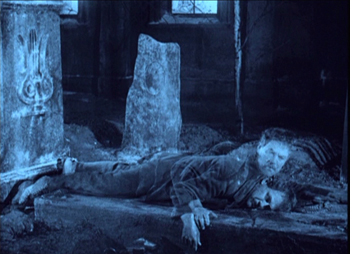 newly dead; it is driven each year by the last person to die at the end of the previous year. Holm then dies, and the carriage arrives, with its current driver ready to turn over the job to him. Flashbacks enact both the circumstances of how the heroine met Holm and the happy family whom Holm had alienated through his drunkenness.
newly dead; it is driven each year by the last person to die at the end of the previous year. Holm then dies, and the carriage arrives, with its current driver ready to turn over the job to him. Flashbacks enact both the circumstances of how the heroine met Holm and the happy family whom Holm had alienated through his drunkenness.
It’s a deeply affecting story, wonderfully acted and staged. In most scenes the lighting and staging are impeccable, and the famous superimpositions that portray the carriage and the dead are highly ambitious for the period and impressively executed. The filmmakers have managed to make the carriage, superimposed on real landscapes, appear to pass behind rocks and other large objects. In short, a film that has everything going for it.
Death himself appears in Der müde Tod (literally “The Tired Death,” often called Destiny, or occasionally in the old days, The Three Candles). Here the great German director Fritz Lang hits his stride, and you can expect him to figure on most of our lists from now on.
In Destiny (available on DVD from Image Entertainment) a young woman’s fiancé is killed early on. Death, a sympathetic figure who regrets what he must do, gives her three chances to find another person whose demise can substitute for her lover’s. The three episodes in which she tries take place in Arabian-Nights Baghdad, Renaissance Venice, and ancient China; each story casts her as the heroine and her lover as the hero.Things don’t go well, and Death actually gives her a fourth chance when she returns to the present.
This was Lang’s first venture into the young German Expressionist movement, which had been launched the year before with Das Cabinet des Dr. Caligari. The style shows up only intermittently, perhaps most dramatically in the Venetian episode when the lover shinnies up a rope along a wall painted with a gigantic splash of light. (See bottom.)
Each film has a “happy ending.” I leave it to you to determine which is grimmer.
I’m turning over the keyboard to David now, to describe a film he knows better than I do.
More Northern European drama
Mauritz Stiller alternated urban comedies (Thomas Graal’s Best Film, 1917; Thomas Graal’s Best Child, 1918; Erotikon, 1920) with more lyrical dramas and romances set in the countryside (Song of the Red Flower, 1919; Sir Arne’s Treasure, 1919). Johan (1921) is in the pastoral vein. Its integration of landscape into the drama suggests it was an effort to recapture the production values that overseas critics had praised in Sjöström’s Terje Vigen (1917) and The Outlaw and His Wife (1918). Like the Sjöström films, however, Johan offers more than splendid spectacle; it’s the study of the undercurrents of a marriage.
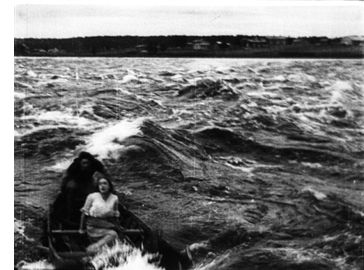 At the core is a love triangle. The fisherman Johan is the somewhat thick-headed son of a domineering mother. He is fond of the girl Merit, whom he and his mother rescued as a waif and brought into their household. But this synopsis is actually skewed, because Stiller and the scriptwriter Arthur Norden have told the story in an unusual way.
At the core is a love triangle. The fisherman Johan is the somewhat thick-headed son of a domineering mother. He is fond of the girl Merit, whom he and his mother rescued as a waif and brought into their household. But this synopsis is actually skewed, because Stiller and the scriptwriter Arthur Norden have told the story in an unusual way.
We’re introduced to the couple by following the rogue Vallavan’s entry into the town; Johan seems almost a secondary character until Vallavan leaves. When Johan breaks his leg, Merit agrees to be his wife. Now we’re attached to her standoint and see her life of drudgery under the petty tyranny of Johan’s mother. Vallavan returns, and Merit falls under his spell. Taking her hand, he says, “I want to rescue you.” After she has fled with him, Johan clumsily wanders the rocky shore. “Will I ever see Merit again in this life?” The narrational weight passes to him as he decides to pursue the runaways.
Like Sjöström’s Sons of Ingmar (1918-1919), Johan presents marriage as a trap for unwary women. Our shifting attachment, from Vallavan to Merit and eventually to Johan, allows us to see the situation in many dimensions. As a sort of parallel, Stiller makes fluid use of the now solidly-established conventions of continuity editing. Vallavan’s seduction of Merit is played out in tense shot/ reverse-shot, and there’s an engrossing moment involving delicate shifts in point of view. When the bedridden Johan sees Merit leaving, after his mother has cast her out of the house, he must smash a window pane with his elbow in order to call to her. Stiller’s dynamic eyelines, direction of movement, and precise changes of camera setup here show that he had mastered the American style.
Alongside this finesse, there is still plenty of outdoor action, highlighted when Vallavan rows Merit away in the tumultuous river. Filmed from another boat, the actors are all but engulfed by the waves. It was presumably scenes like this that the parent company, Svensk Filmindustri, hoped would attract international attention. At this period Svensk, dominant in the local industry, was hoping to sell its films on a global scale. That ambitious plan failed, but it left us with many outstanding movies and soon brought Stiller, along with Sjöström, to Hollywood.
Johan is available on a Region 2 PAL DVD, coupled with Kaurismaki’s Juha, another adaptation of the Juhani Aho story.
The joys of small-town life
Last year I included two films by William C. deMille, the considerably less famous brother of Cecil B. The year 1921 saw the release of what is today his best-known film, Miss Lulu Bett. It was based 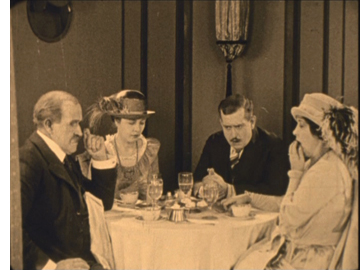 on the popular novel and play by Wisconsin author Zona Gale, who received her MA here at the University of Wisconsin-Madison and in 1921 became the first woman to win a Pulitzer Prize for drama. The story centers around the heroine, a spinster who lives with her sister’s family, including her niece, nephew, and brother-in-law, Dwight Deacon. Dwight is a tyrant who delights in taunting Lulu over her unwed status, and the rest of the family treats her as a servant.
on the popular novel and play by Wisconsin author Zona Gale, who received her MA here at the University of Wisconsin-Madison and in 1921 became the first woman to win a Pulitzer Prize for drama. The story centers around the heroine, a spinster who lives with her sister’s family, including her niece, nephew, and brother-in-law, Dwight Deacon. Dwight is a tyrant who delights in taunting Lulu over her unwed status, and the rest of the family treats her as a servant.
The return of the husband’s globetrotting younger brother Ninian after a twenty-year absence injects some life into the situation. Taking the family out to dinner, he realizes just how boring the family is (right), and to liven things up, suggests that he and Lulu perform mock marriage vows. Dwight realizes that the ceremony is legally binding, and, already attracted to Lulu, Ninian suggests that they treat it as a real marriage. Desperate to escape her dreary situation, Lulu agrees. The relationship proves agreeable, and Lulu declares that she will learn to love Ninian–when he reveals that he had previously been married, though he doesn’t know whether his first wife is dead (in which case he and Lulu are married) or alive (in which case they aren’t). Unwilling to take a chance, Lulu returns to the Deacons, who consider her disgraced and treat her even worse.
The film avoids melodrama. Ninian is not a villain; he’s kind to Lulu and sorry for the position he’s placed her in. It remains to Lulu to summon the gumption to leave the family and find her own happiness.The whole thing is told with restraint and little touches of humor that draw the viewer into a deep sympathy with Lulu’s plight.
Lois Wilson’s performance as Lulu is crucial in this. She is at once plain enough that we can believe she is in danger of becoming an old maid and pretty enough to plausibly attract the attention of the handsome local schoolteacher. Wilson’s most prominent role came two years later, when she starred as the heroine in James Cruze’s The Covered Wagon.
Miss Lulu Bett is the only one of William’s films available on DVD, paired with Cecil’s Why Change Your Wife? As so often happened, William seems to take a back seat to his famous brother, but the pairing is a logical one, in that William wrote the script for Why Change Your Wife?
Another small-town drama of the same year is Lois Weber’s The Blot. In 1981, when I was teaching a course on American silent film at the University of Iowa, I wanted to quickly demonstrate to the students that the silent period was not an era of exaggerated acting and naively melodramatic plots. I showed a double feature of The Blot and King Vidor’s Wine of Youth (1924). The latter portrays changing sexual mores through the story of three generations of the same family, with a young woman of the Roaring Twenties questions the necessity of marriage when she discovers that her mother is contemplating divorce. I think Wine of Youth (unfortunately not available on video) and The Blot convinced my class that silent films could be both sophisticated and subtly acted.
The “blot” of Weber’s title refers to the notion that people in professions depending on intelligence and education are poorly paid, while tradespeople and children from rich families are well off. The representatives of the underpaid are a college teacher, Prof. Griggs, and a young, idealistic minister. The parallels to recent events are striking. College professors may not be so badly paid as in the 1920s, but the move toward institutions of higher learning depending on adjunct lecturers has created a similar issue. In general, the income gap is familiar: the rich young wastrels taking Prof. Griggs’s course represent what we now call the one percent, while the professor and minister live on a much lower plane.
Weber’s drama is not quite this bald, however. Various levels of prosperity are represented. The professor’s family lives in shabby gentility, his wife grimly struggling to keep food on the table and his daughter Amelia, in delicate health due to a lack of nourishing food, working in the local library. Their neighbors are the family of a successful shoemaker, who live well but lack education. The shoemaker’s wife in particular resents what she perceives as intellectual snobbishness in the professor’s family and takes every opportunity she can to flaunt her comparative wealth.
Her son, however, has a crush on Amelia, as does the poor minister. Into this situation comes Phil West, the professor’s rich but indolent and mischievous student. Also attracted to Amelia, Phil for the first time encounters real poverty and is 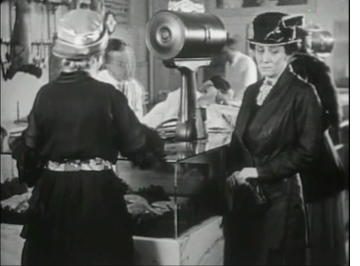 shocked by it. As the plot develops, Amelia falls ill, and her mother’s increasingly desperate efforts to obtain the food necessary to nurse her to health become one of the main threads of the drama. To say that a large part of the action in the second half of the film centers on Mrs. Griggs’s temptation to steal a chicken from her neighbors might make the situation seem a trifle comic, but Margaret McWade’s remarkable performance vividly conveys the wife’s struggle in the face of real lack and her humiliations in the eyes of the shoemaker’s gloating wife. When Mrs. Griggs succumbs to temptation, the result is a brief but wrenching scene.
shocked by it. As the plot develops, Amelia falls ill, and her mother’s increasingly desperate efforts to obtain the food necessary to nurse her to health become one of the main threads of the drama. To say that a large part of the action in the second half of the film centers on Mrs. Griggs’s temptation to steal a chicken from her neighbors might make the situation seem a trifle comic, but Margaret McWade’s remarkable performance vividly conveys the wife’s struggle in the face of real lack and her humiliations in the eyes of the shoemaker’s gloating wife. When Mrs. Griggs succumbs to temptation, the result is a brief but wrenching scene.
The plot is remarkably dense and unpredictable. Every scene involves glances that lead to new knowledge or serious misunderstanding, deflecting the plot into new directions. Early on it is impossible to say which of the three young men Amelia will end up with, and even by the late scenes, when only two plausible romantic candidates remain, we have no idea which she will pick. As in many of Weber’s films, she does a bit of preaching about the social problem involved, but in The Blot she leaves this until near the end and gets it over quickly and fairly believably. The considerable but gradual change in Phil’s attitude toward education and the problems of poverty is also made believable. The prosperous neighbor’s change of attitude may seem a bit sudden, though it is somewhat motivated by a line early on.
But on the whole, even more than with Miss Lulu Bett, this is an absorbing story with characters for whom we care. Weber uses motifs as skillfully as any director in the early phase of the classical Hollywood cinema. Watch in particular how many different ways she uses the Griggs family’s cat and her two kittens: to demonstrate the family’s poverty, to be the main means of the neighbor lady’s spite, to introduce some comedy, and so on. Even more pervasive is the way that shoes become tokens of characters’ various social positions.
The Blot is available on DVD from Image. Those interested in Weber as a director should note that next summer’s Il Cinema Ritrovato festival in Bologna plans a retrospective of her work.
Which is best? Damfino.
In past year-end lists, we’ve watched Harold Lloyd, Charles Chaplin, and Buster Keaton creeping toward their great features of the 1920s. This year two of them move cautiously into longer films, and the other releases two more terrific one-reelers.
The Boat is one of Keaton’s most admired shorts. In it, he, his wife, and their two young sons build a boat, the Damfino, and unwisely launch it on the open ocean. Everything that can go wrong does: the life-preserver sinks, the anchor floats, and naturally a storm hits. The wife’s pancakes aren’t edible, but one temporarily patches a leak. Throughout the intrepid band carries on against all obstacles.
Less perfect but more dazzling and (perhaps) funnier is The Playhouse. The premise of a small variety theater creates an episodic, messy narrative, but it allows Keaton to play out a series of four “acts.” Initially we see Keaton buy a ticket and enter an auditorium where the audience, the orchestra, and all the performers are played by “Buster Keaton.” As one of the audience members remarks, “This fellow Keaton seems to be the whole show,” which is true in more way than one. The multiple images of Keaton were accomplished entirely in the camera, by cranking back the film with precise timing and uncovering a different part of the lens at each pass. The precision when one Keaton figure talks to or dances with another is amazing.
This all turns out to be a stagehand’s dream. (Keaton being the stagehand.) The multiplication motif returns as an act involving two pretty girls who happen to be twins–something Buster 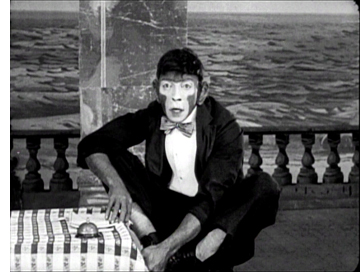 doesn’t know, making his encounters with them ever more baffling. Later an orangutan escapes, and Buster dons make-up and costume to replace him. All hilarious stuff, though unfortunately the final act, a Zouave Guard drill, is the least funny one. Still, it’s a terrific film with a big dose of the surrealist quality that will run through the later shorts and the features.
doesn’t know, making his encounters with them ever more baffling. Later an orangutan escapes, and Buster dons make-up and costume to replace him. All hilarious stuff, though unfortunately the final act, a Zouave Guard drill, is the least funny one. Still, it’s a terrific film with a big dose of the surrealist quality that will run through the later shorts and the features.
The Boat is included on Kino’s disc of The Navigator and The Playhouse with their out-of-print DVD of The General. Still in print, however, is Kino’s eleven-disc set of the features and shorts. For those in the UK and other region-2 countries, Eureka! has a “Masters of Cinema” three-disc set, “Buster Keaton: The Complete Short Films 1917-1923,” which includes many of his earlier films with Fatty Arbuckle.
The year saw Lloyd and Chaplin make their first feature films, though both releases were still fairly short. I’m not really counting A Sailor-Made Man as one of the top ten of the year, since it’s a delightful but decidedly light item. Just another reminder that Lloyd is inching toward greatness.
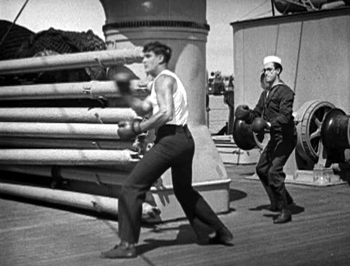 Lloyd presents his “glasses” character as a brash young man who impulsively proposes to a rich man’s daughter. When the father demands that he get a job to prove his worth, Harold enlists in the navy. Highjinks ensure, culminating in a lively chase-and-rescue scene when the heroine gets kidnapped by a lecherous Arabian sheik.
Lloyd presents his “glasses” character as a brash young man who impulsively proposes to a rich man’s daughter. When the father demands that he get a job to prove his worth, Harold enlists in the navy. Highjinks ensure, culminating in a lively chase-and-rescue scene when the heroine gets kidnapped by a lecherous Arabian sheik.
The shipboard scenes allow Harold to get in some funny bits, mainly involving him trying to be tough and succeeding at first by sheer accident. Later, however, he is inspired by the heroine’s danger to become a real rescuer. It’s a sign of bigger things to come.
New Line’s Harold Lloyd boxed set is out of print, but you can still get the volumes separately. A Sailor-Made Man is in Volume 3, along with such delights as Hot Water and For Heaven’s Sake.
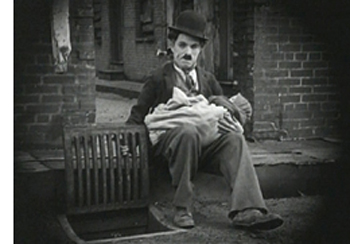 Chaplin’s first feature, The Kid, is a skillful blend of the rough-and-tumble slapstick that had characterized his early shorts and the sentimentality that would gradually become a more prominent trait of his films. A unmarried woman (played by Edna Purviance, the elegant beauty who made such a contrast with the Little Tramp in many of his films) abandons her infant in an expensive car which happens to get stolen moments later. Charlie finds the baby, and after numerous attempts to get rid of it–including a brief contemplation of an open storm-sewer grate–decides to raise it. The baby grows into the adorable and amusing Jackie Coogan.
Chaplin’s first feature, The Kid, is a skillful blend of the rough-and-tumble slapstick that had characterized his early shorts and the sentimentality that would gradually become a more prominent trait of his films. A unmarried woman (played by Edna Purviance, the elegant beauty who made such a contrast with the Little Tramp in many of his films) abandons her infant in an expensive car which happens to get stolen moments later. Charlie finds the baby, and after numerous attempts to get rid of it–including a brief contemplation of an open storm-sewer grate–decides to raise it. The baby grows into the adorable and amusing Jackie Coogan.
In the meantime, the mother has become a rich singer, and coincidentally she comes to the slums doing charitable work. The authorities eventually try to remove the Kid to an orphanage, and later a flop-house proprietor turns him in to receive a reward. Still, Chaplin doesn’t milk the pathos, and a happy ending duly arrives.
The Kid is available in a decent print along with A Day’s Pleasure and Sunnyside on the “Charlie Chaplin Special” DVD. Our recording off Turner Classic Movies strikes me as being slightly better quality, so you might keep an open to see if they reshow it. It was also announced this week that The Kid has been added to the National Film Registry of the Library of Congress.
Fuzzy movies, big and small
Soft-style cinematography had been tried in some films of the late 1910s, most notably in Griffith’s Broken Blossoms. But in the 1920s it spread. In Hollywood, it was mainly a technique for making beautiful images and especially for creating glamorous close-ups of actresses. In France, it was a way of tracking a character’s inner life.
Vicente Blasco Ibáñez’s 1918 novel, The Four Horsemen of the Apocalypse was a huge bestseller, and the first film adaptation in 1921, directed by Rex Ingram, was equally successful. To many, it is remembered for having made a super-star of its main actor, Rudolph Valentino. Anyone who has seen him as the caricatured Latin Lover of his later films will be pleasantly surprised to discover that the man could act, as could his leading lady, the lovely Alice Terry.
Ingram was the quintessential middlebrow director of the 1920s, doing big-budget, respectable adaptations of popular literature (e.g., Scaramouche, The Prisoner of Zenda). To me, Four Horsemen escapes the stodginess of the later films, at least to some extent (as does his other 1921 film, The Conquering Power). It and the other film in this section were borderline cases, chosen as much for their historical importance as their quality, perhaps, but definitely worth watching.
One of Four Horsemen‘s greatest strengths is its photography. Ingram worked consistently with one of the greatest cinematographers of the 1920s, John F. Seitz, who created glowing images of 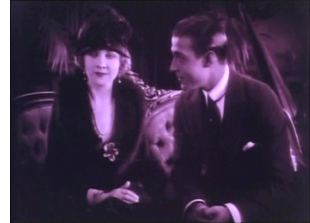 sets and actors with selective lighting and all sort of means of softening the image. This film, more than Broken Blossoms, brought the soft style into vogue. It eventually culminated in the Dietrich films of Josef von Sternberg before a more hard-edged look came to dominate the 1940s.
sets and actors with selective lighting and all sort of means of softening the image. This film, more than Broken Blossoms, brought the soft style into vogue. It eventually culminated in the Dietrich films of Josef von Sternberg before a more hard-edged look came to dominate the 1940s.
Four Horsemen was also an early entry in the anti-World War I genre of the 1920s and 1930s. Its final scene in a vast military cemetery of identical white crosses remains a powerful one. (See above.) Here, however, the Germans are still stereotypes, militaristic puppets with no redeeming features. Even that notion would gradually change, however, until nine years later All Quiet on the Western Front could recount the war from the German point of view.
Four Horsemen is available on DVD on demand from Amazon, supplied on DVD-R. In the same format, one can order it on a set with a documentary on Valentino. The reviews of the latter suggest that the visual quality is good.
(For more on this photographic style, see my “The soft style of cinematography,” in The Classical Hollywood Cinema, pp. 287-293.)
I’m not a huge fan of Marcel L’Herbier, and I’m not entirely sure that El Dorado is a full-fledged 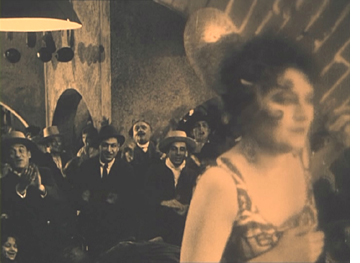 masterpiece. But it has many virtues, and arguably it’s historically important as the first film of the French Impressionist movement to thoroughly explore ways in which camera techniques could convey perceptual and psychological states. It focuses largely on Sibilla, a singer-dancer who is the main attraction in a tawdry Spanish bar. She and some other women are performing as the story begins, but Sibilla is distracted by worries about her sick son. L’Herbier experimented with tracing her attention by placing gauzy filters over her face when she starts thinking of the boy. In the frame at the left, for example, she is in sharp focus when onstage, but as she passes into the backstage area, she goes fuzzy.
masterpiece. But it has many virtues, and arguably it’s historically important as the first film of the French Impressionist movement to thoroughly explore ways in which camera techniques could convey perceptual and psychological states. It focuses largely on Sibilla, a singer-dancer who is the main attraction in a tawdry Spanish bar. She and some other women are performing as the story begins, but Sibilla is distracted by worries about her sick son. L’Herbier experimented with tracing her attention by placing gauzy filters over her face when she starts thinking of the boy. In the frame at the left, for example, she is in sharp focus when onstage, but as she passes into the backstage area, she goes fuzzy.
In a way this is a somewhat silly, literal notion, and yet it’s exciting to see filmmakers exploring new devices relatively early in film history. Gauzy filters, distorting mirrors, slow-motion superimpositions, rhythmic cutting, and subjective moving camera were soon to be in common use by a small group of French directors. El Dorado was also the first film to be filmed within the Alhambra, which lends it considerable visual interest.
If we’re still writing this blog in 2019, our list will probably include the culminating film of the movement, and arguably L’Herbier’s best silent film, L’Argent.
Not many French Impressionist films are available in the U.S. If you have a multi-region player, El Dorado is paired with L’Herbier’s earlier L’homme du large (1920) on a French DVD.
Tigers and lepers and a mysterious yogi
We tend to think of serials as having many episodes and being low-budget additions to programs. That’s the American model, but in Europe things were different. Louis Feuillade’s serials are among the gems of the 1910s. In Germany, serials tended to have fewer episodes but bigger budgets–much bigger. Many were only two parts, most famously Dr. Mabuse, der Spieler (coming next year to our top-ten list) and Die Nibelungen (coming in 2014). Lang had launched into serials with Die Spinnen (1919 and 1920). The two parts have terrific things in them, but Lang never went on to finish it.
He was, however, still collaborating on screenplays for director Joe May, who specialized in epic serials set in exotic countries and starring his wife, Mia May. Highly entertaining though these films are, they are largely forgotten, even by most lovers of silent cinema. Das indische Grabmal is the exception, though even now few have had a chance to see it. In 1996 it was shown at “Il Gionate del Cinema Muto” festival in Pordenone and was all too briefly available on an Image DVD (as The Indian Tomb) now out of print. Track it down if you can.
Full of the stars of its day, Das indische Grabmal is set largely in India, and its plot was inspired by the Taj Mahal. A ruthless maharajah (played with relish by Conrad Veidt) cloaks his cruelty under a veneer of European courtesy. He plots to shut his unfaithful princess (Erna Morena) in a beautiful tomb along with her lover (Paul Richter, better known to modern audiences as Siegfried). He calls in a famous European architect (Danish star Olaf Fønss) to build it, and the architect’s fiancée (Mia May), rightly fearing dirty work afoot, follows. One pit full of tigers and one of lepers lie waiting to endanger the visitors. The sets are beautiful. The Germans by this point could do them at full scale (above left) and as marvelously deceptive miniatures (above right). Das indische Grabmal is constantly entertaining and perhaps the best of its type, at least of the films we have access to.
Lang directed a two-part remake of this film in 1959. Both are good, but I prefer the silent one.
Some runners-up
As I mentioned, we had trouble narrowing down our list this year. Here are some others that could have replaced some of our prime choices. The German stage director Leopold Jessner adapted the play Hintertreppe (Backstairs). It’s a Kammerspiel, set in two apartments and the courtyard between them, and concerns a simple love triangle among a maid, her absent lover, and the postman who loves the maid so much that he forges letters from her sweetheart to keep her happy. Antti Alanen kindly reprinted my notes on the film here.
Carl Dreyer’s third feature, Leaves from Satan’s Book, remains one of the most widely-admired variants on the Intolerance formula of presenting thematically linked historical episodes. The dynamic final last-minute non-rescue shows that Dreyer learned a good deal from Griffith’s crosscutting too. Leaves is available on a Danish DVD with English subtitles and an alternate ending. Murata Minoru’s Japanese feature Souls on the Road, another exercise in complex crosscutting, and Feuillade’s polished L’Orphéline are solid runners-up as well. Neither is available on commercial DVD, as far as we know.
Destiny.
More revelations of film history on DVD
The Great Consoler.
Kristin here:
Upon returning from Vancouver, we found the usual mountain of mail awaiting us. Among the bills and ads were some very welcome items: a new flock of DVDs of considerable historical interest.
A German Documentary on Veit Harlan
After Leni Reifenstahl, Veit Harlan is the most famous of the directors who made films for the Nazi regime. He made Jud Süss, which is the only non-Riefenstahl Nazi film you might have seen apart from Triumph of the Will and (if you think it’s Nazi propaganda) Olympia.
Now Felix Moeller has made a documentary film, Harlan: Im Schatten von Jud Süss (“In the Shadow of Jud Süss,” c. 100 minutes). It’s available on a German DVD from Edition Salzgeber and can be purchased from Amazon Germany. (Beware, it’s coded Region 2, so you’ll need a multi-region player.) It has English subtitles, a feature some European DVD makers wisely include, since they know that there are a lot of us out here with multi-regional players. A region 1 version will also be released in the U.S. on November 23 and is available for pre-orders on Amazon.
Harlan is a fascinating film, both in terms of its subject matter and its strategies. It starts out in a fairly conventional way, showing Harlan’s grave, and then drops a few brief clips from Jud Süss in among shots introducing some of the director’s descendants. He was married twice and had five children, who in turn had children, and there are nephews and nieces as well. At one point one granddaughter draws a family tree to help us out. (The small accompanying booklet has a “who’s who” feature with photos to help us keep the family members straight. This booklet is entirely in German.)
Much of the early part of the film is taken up with the story of Harlan’s career making films for the Nazis, being found innocent after two trials in the post-war era, and continuing his filmmaking into the 1950s. A nicely ironic comparison is made between Harlan’s “I was just following orders” defense and the identical defense that Süss makes during his trial scene in the film.
Initially the relatives seem to be present in part to provide information and in part to comment on Harlan’s life. Later in the film, however, we realize that “the shadow of Jud Süss” falls over them as well, and they have reacted in a wide variety of ways. A expository motif that runs through the film is a visit paid by several of the younger family members to an exhibition on the film (see below), where they (and we) are shown documents and clips.
One son, Thomas, denounced his father publicly and for decades sought evidence to convict Nazi war criminals. (Thomas Harlan died last weekend; see David Hudson’s obituary here.) Kristian Harlan and Maria Körber, his half-brother and half-sister, criticize him for not keeping his attitudes toward his father in the family. Thomas’ daughter Alice works as a physiotherapist in Paris and realizes she does not share her grandfather’s guilt–yet she worries about some sort inherited taint. Another son, Caspar, became an anti-nuclear activist, along with his wife and three daughters. Two sisters, Maria Körber and Susanne Körber both married Jews, almost as if to make amends for their father’s implicit role in the extermination of these men’s families; neither marriage ended well. A niece, Christiane, married Stanley Kubrick, who as a Jew was both shocked and fascinated by her relationship to Veit Harlan; he at one point planned to make a film on the Nazi director. Christiane’s brother ended up producing some of Kubrick’s films.
One thing that struck me was the generational difference in the attitudes toward Jud Süss itself. The first generation of sons, daughters, nieces, and nephews find it powerful, reprehensible, and disturbing. One of the granddaughters, however, considers it “so cheesy, and really banal, too,” wondering how anyone in the 1940s could have taken it seriously. This seems to reflect an attitude that many young people have toward old films; 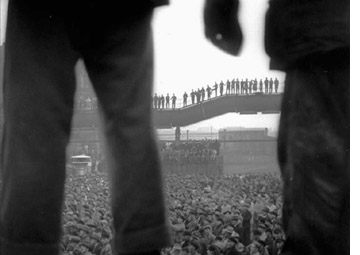 she might be just as dismissive of a classic John Ford film of the same era. It’s a good argument in favor of teaching students about the conventions of older films and helping them to watch them with more respect. Not knowing at least a little about the historical context could easily make younger generations not take the propaganda of the past any more seriously than they take the entertainment films of Hollywood in the 1930s and 1940s. (One can’t fault the granddaughter too much; she belongs to the family of anti-nuclear activists.)
she might be just as dismissive of a classic John Ford film of the same era. It’s a good argument in favor of teaching students about the conventions of older films and helping them to watch them with more respect. Not knowing at least a little about the historical context could easily make younger generations not take the propaganda of the past any more seriously than they take the entertainment films of Hollywood in the 1930s and 1940s. (One can’t fault the granddaughter too much; she belongs to the family of anti-nuclear activists.)
The filmmakers had extensive access to good prints of several of Harlan’s major films. One, Der Herrscher (“The Master,” 1937), deals with a factory whose owner is a strong leader type. The frame at left shows off Harlan’s feel for crowds that made him the equivalent for fiction film to Leni Riefenstahl as a documentarist. (Indeed, one might suspect a bit of influence here.) There are also home movies, some taken behind the scenes during the filming of Harlan’s Nazi-era films. Munich archivist Stefan Drössler adds some historical perspective. The exhibition shown in the film provides glimpses of key documents.
Harlan could be quite useful in the classroom. Obviously courses on German history would benefit from it. Film history classes could show it in a unit on Nazi cinema, either in combination with or as a replacement for Jud Süss or one of the other major Nazi film. But it also gives an interesting perspective on the post-war decades and the ways in which guilt and expiation could linger across generations.
Thanks to my friend Marianne Eaton-Krauss for recommending this film to me!
[Added October 31: Critic Kent Jones has kindly written to point out that Felix Moeller is Margarethe Von Trotta’s son. Kent has written a piece on Veit and Thomas Harlan in the May/June 2010 issue of Film Comment.]
The launch of a Russian DVD series
The Russian Cinema Council (RUSICICO) has recently released the first five DVDs in its new “Academia” series. The first group comes from the Soviet silent and early sound era: Strike, October, Happiness, The Great Consoler, and Engineer Prite’s Project. They can easily be ordered on the company’s website. Googling will find a few smaller online companies in Europe that sell them, but they are not available (yet, at least) from the larger sites like Amazon.
[January 31, 2012: Hyperkino has announced that its DVDs can now be purchased at a British site, MovieMail. For more on Hyperkino, see here.]
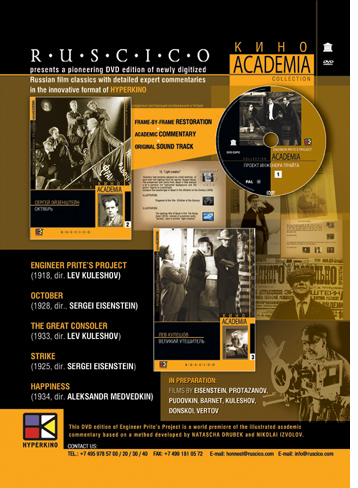 A major feature of these discs is “Hyperkino,” a version in which numbers appear at intervals in the upper right; clicking on them summons up an explanatory text. For Strike, for example, one can read an explanation of the “Collective of the 1st Works’ Theater” when that phrase appears in the credits. (The complete text of the annotations for Engineer Prite’s Project have been printed as an article in Studies in Russian and Soviet Cinema [Vol. 4, no. 1, 2010].) These “footnotes” would be of interest to film students, mainly at the graduate level; they would be invaluable for lecture preparation. The Hyperkino version appears on the first disc of each two-disc set; the film without the feature appears on the other disc. Despite the fact that the text on the boxes are almost entirely in Russian, the films have optional subtitles in English, French, Spanish, Italian, German, and Portuguese; the Hyperkino notes are available only in Russian or English. The discs have no region coding.
A major feature of these discs is “Hyperkino,” a version in which numbers appear at intervals in the upper right; clicking on them summons up an explanatory text. For Strike, for example, one can read an explanation of the “Collective of the 1st Works’ Theater” when that phrase appears in the credits. (The complete text of the annotations for Engineer Prite’s Project have been printed as an article in Studies in Russian and Soviet Cinema [Vol. 4, no. 1, 2010].) These “footnotes” would be of interest to film students, mainly at the graduate level; they would be invaluable for lecture preparation. The Hyperkino version appears on the first disc of each two-disc set; the film without the feature appears on the other disc. Despite the fact that the text on the boxes are almost entirely in Russian, the films have optional subtitles in English, French, Spanish, Italian, German, and Portuguese; the Hyperkino notes are available only in Russian or English. The discs have no region coding.
The prints of Strike and October are both the familiar step-printed versions. The visual quality is reasonably good.
(We did not purchase the Happiness disc, since the film had already been available in DVD and we’re not Medvedkin specialists.)
The most important contribution of the series so far has been to make two rare Kuleshov titles available to the general public for the first time. Engineer Prite’s Project was his first film. Previously it was available in archives in a print lacking intertitles. The story was so difficult to follow that the film seemed to be incomplete. Now, with the intertitles reconstructed and inserted into the film, it makes sense. It’s a short feature about industrial intrigue, notable in its mixture of traditional European tableau staging style and some sophisticated American-style editing that was a complete innovation for Russian cinema. The release of Engineer Prite’s Project on DVD fills a large gap in the history of the Soviet silent cinema, since it was the first film by one of the group that would form the Montage movement. Indeed, the fast cutting in a brief fight scene looks forward to that movement:
The DVD also includes a documentary, The Kuleshov Effect, made in 1969. It’s a helpful overview, with clips from the major films up to The Great Consoler, along with interviews with Kuleshov, scenarist and Russian Formalist critic Viktor Shklovski, and others. It’s just under an hour and would be a great teaching tool for a history or theory class.
If Engineer Prite’s Project is of interest mainly for its historical significance, The Great Consoler is perhaps Kuleshov’s masterpiece. The complex, multi-leveled narratives so popular in contemporary cinema have nothing on this film’s storytelling. It shifts among three levels with thematic parallels. In one, an abused, miserable shop girl (played by Alexandra Khokhlova, Kuleshov’s wife and leading proponent of the “biomechanical” school of acting) reads O. Henry short stories as escapism. In another, O. Henry himself is seen in prison (as he was in real life). In a third, we see a dramatization of his tale of convict Jimmy Valentine (“A Retrieved Reformation”). Each level is filmed in a slightly different style, and the moralistic lesson–those who suffer from exploitation under capitalism find only hollow consolation in popular culture–is somewhat undercut by the zestful stylization with which Kuleshov presents the sentimental tale of Valentine.
Chaplin (Slowly) Becomes The Little Tramp
On October 26, Flicker Alley is coming out with another of its big boxes of restored films. (Amazon has it available for pre-order.) This time it’s four discs containing a group of 34 of Charlie Chaplin’s Keystone-era films (of the 35 he made there). The press release describes the lengthy process of finding and restoring prints, which involved several archives:
With the support of Association Chaplin (Paris), 35mm full aperture, early-generation materials were gathered over an eight year search on almost all the films from archives and collectors 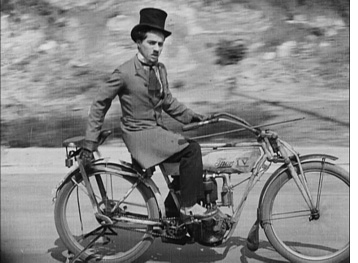 around the world, and were painstakingly piece together and restored by the British Film Institute National Archive, the Cineteca di Bologna and its laboratory L’Immagine Ritrovata in Italy, and Lobsters Films in Paris. Most are now clear, sharp and rock-steady, although some reveal that their source prints are well-used and a handful survive only in 16mm.
around the world, and were painstakingly piece together and restored by the British Film Institute National Archive, the Cineteca di Bologna and its laboratory L’Immagine Ritrovata in Italy, and Lobsters Films in Paris. Most are now clear, sharp and rock-steady, although some reveal that their source prints are well-used and a handful survive only in 16mm.
The earlier films in the set remind us that Chaplin began as a player in films where Mabel Normand was the star attraction (and she directed them herself). He didn’t always wear his “Little Tramp” outfit, either. Such films as The Property Man, The Rounders (co-starring Fatty Arbuckle), and Tillie’s Punctured Romance (restored by the UCLA archive) are included. A trim little booklet by Jeffrey Vance includes historical background and program notes. Original musical accompaniment is provided by Neil Brand, Robert Israel, and others. On-disc bonus materials include a documentary, “Inside the Keystone Project” and a couple of Chaplin-related silent films from the era, including a cartoon featuring him as a character.
Chaplin devised his “Little Tramp” outfit during this early era, though he didn’t use it in every Keystone film. He wasn’t yet the poignant figure of the later 1910s and 1920s. In Mabel at the Wheel, for example, he’s a pugnacious, bomb-wielding villain, with Mabel Normand, who directed the film, in the lead. (At left above, he belatedly 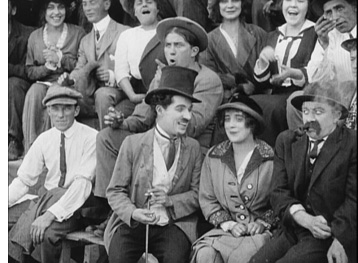 discovers that Mabel is no longer seated behind him on the motorcycle.) Chaplin buffs will have a field day with this set. The clarity makes it easier to spot the many comics who play bit roles here. Mack Swain wanders through, Mack Sennett has a small role as a yokel, and one can see a very young Edgar Kennedy seated behind Chaplin in the bleachers (right).
discovers that Mabel is no longer seated behind him on the motorcycle.) Chaplin buffs will have a field day with this set. The clarity makes it easier to spot the many comics who play bit roles here. Mack Swain wanders through, Mack Sennett has a small role as a yokel, and one can see a very young Edgar Kennedy seated behind Chaplin in the bleachers (right).
Each film is preceded by a title card that specifies the source material for the restoration, as well as the archives and other institutions involved. Mabel at the Wheel, for example, was assembled from four nitrate prints held by various collections. As the frames here indicate, it’s generally very clear and undamaged, though occasionally a shot from a more worn print appears.
We often complain about seeing films for the first time on DVD when they were meant to be seen on celluloid projected on the big screen. But for rare silent films like these Chaplin shorts, DVD replaces the old 8mm and 16mm prints that I remember from my graduate-school days in the 1970s. Our friend and colleague Frank Scheide, who was writing his dissertation on Chaplin’s music-hall background, would present programs of such prints in his home, but there were items that remained elusive. (Frank has co-edited two anthologies on Chaplin’s later films; see here and here.) Now we’re lucky enough to have archives restoring films in part to make available in the new format. Most of these images are far better quality than 8mm or even 16mm could render.
As with the giant Georges Méliès boxed set released in 2008, the new Chaplin discs make it easy to go through his career in strict chronological order, either as the films were made or as they were released (often not the same thing in those early days). The set is a vital item for collections of silent films and will no doubt feature among the nominees in the DVD awardsfor next year’s Bologna festival, Il Cinema Ritrovato. Three Hyperkino titles were among last year’s winners.
Mark your calendars!
On November 7, Turner Classic Movies will be showing the new restoration of Metropolis (8 pm Eastern time), followed by a one-hour documentary Metropolis Refound (11 pm Eastern time), on the discovery of a nearly complete print in An Argentinean archive. On November 4, the restored Pandora and the Flying Dutchman (1951; starts at 10 pm Eastern time) will be shown. It’s by the little-known auteur Albert Lewin; if you love Powell and Pressburger movies, you’ll probably love this film. Every Monday from November 1 to December 13, TCM will air its original series, Moguls & Movie Stars (8 pm Eastern time). Each episode will be followed by several films of the era discussed. One highlight not to be missed is Lois Weber’s wonderful 1921 feature, The Blot. It’s probably the only film ever made about the low pay of university professors, but its real strength is in the character study of haves and have-nots living next door to each other. Back when I taught a history of silent cinema class at the University of Iowa in 1980/81, this was one of the films I showed to demonstrate that silent films weren’t as simple and naive as young people today might assume. (The other was King Vidor’s 1924 Wine of Youth.) Set your recorders, since The Blot airs at 4:45 am EST on November 8. For more highlights, keep checking the TCM website, which hasn’t yet posted its November schedule.
Harlan: Im Shatten von Jud Süss













